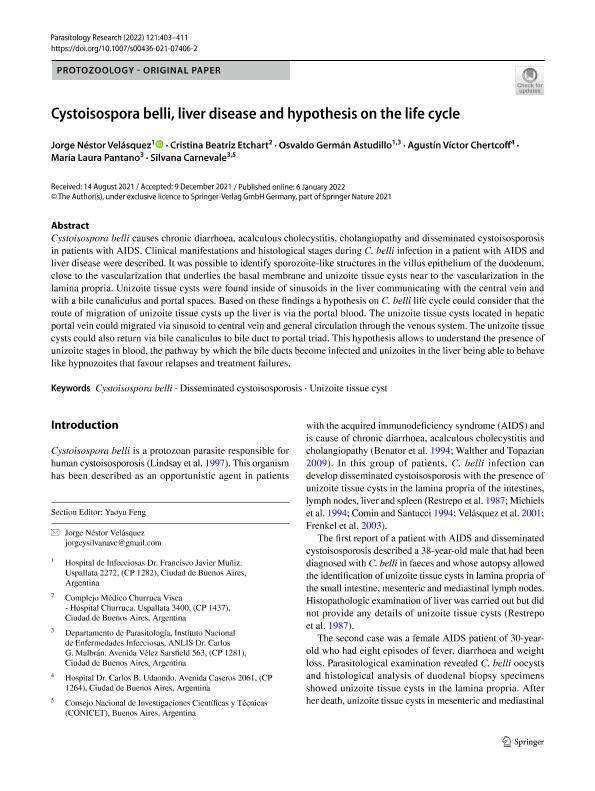Artículo
Cystoisospora belli, liver disease and hypothesis on the life cycle
Velásquez, Jorge Néstor; Etchart, Cristina Beatriz; Astudillo, Osvaldo Germán; Chertcoff, Agustín Víctor; Pantano, María Laura; Carnevale, Silvana

Fecha de publicación:
01/2022
Editorial:
Springer
Revista:
Parasitology Research
ISSN:
0932-0113
Idioma:
Inglés
Tipo de recurso:
Artículo publicado
Clasificación temática:
Resumen
Cystoisospora belli causes chronic diarrhoea, acalculous cholecystitis, cholangiopathy and disseminated cystoisosporosis in patients with AIDS. Clinical manifestations and histological stages during C. belli infection in a patient with AIDS and liver disease were described. It was possible to identify sporozoite-like structures in the villus epithelium of the duodenum, close to the vascularization that underlies the basal membrane and unizoite tissue cysts near to the vascularization in the lamina propria. Unizoite tissue cysts were found inside of sinusoids in the liver communicating with the central vein and with a bile canaliculus and portal spaces. Based on these findings a hypothesis on C. belli life cycle could consider that the route of migration of unizoite tissue cysts up the liver is via the portal blood. The unizoite tissue cysts located in hepatic portal vein could migrated via sinusoid to central vein and general circulation through the venous system. The unizoite tissue cysts could also return via bile canaliculus to bile duct to portal triad. This hypothesis allows to understand the presence of unizoite stages in blood, the pathway by which the bile ducts become infected and unizoites in the liver being able to behave like hypnozoites that favour relapses and treatment failures.
Palabras clave:
CYSTOISOSPORA BELLI
,
DISSEMINATED CYSTOISOSPOROSIS
,
UNIZOITE TISSUE CYST
Archivos asociados
Licencia
Identificadores
Colecciones
Articulos(SEDE CENTRAL)
Articulos de SEDE CENTRAL
Articulos de SEDE CENTRAL
Citación
Velásquez, Jorge Néstor; Etchart, Cristina Beatriz; Astudillo, Osvaldo Germán; Chertcoff, Agustín Víctor; Pantano, María Laura; et al.; Cystoisospora belli, liver disease and hypothesis on the life cycle; Springer; Parasitology Research; 121; 1; 1-2022; 403-411
Compartir
Altmétricas



